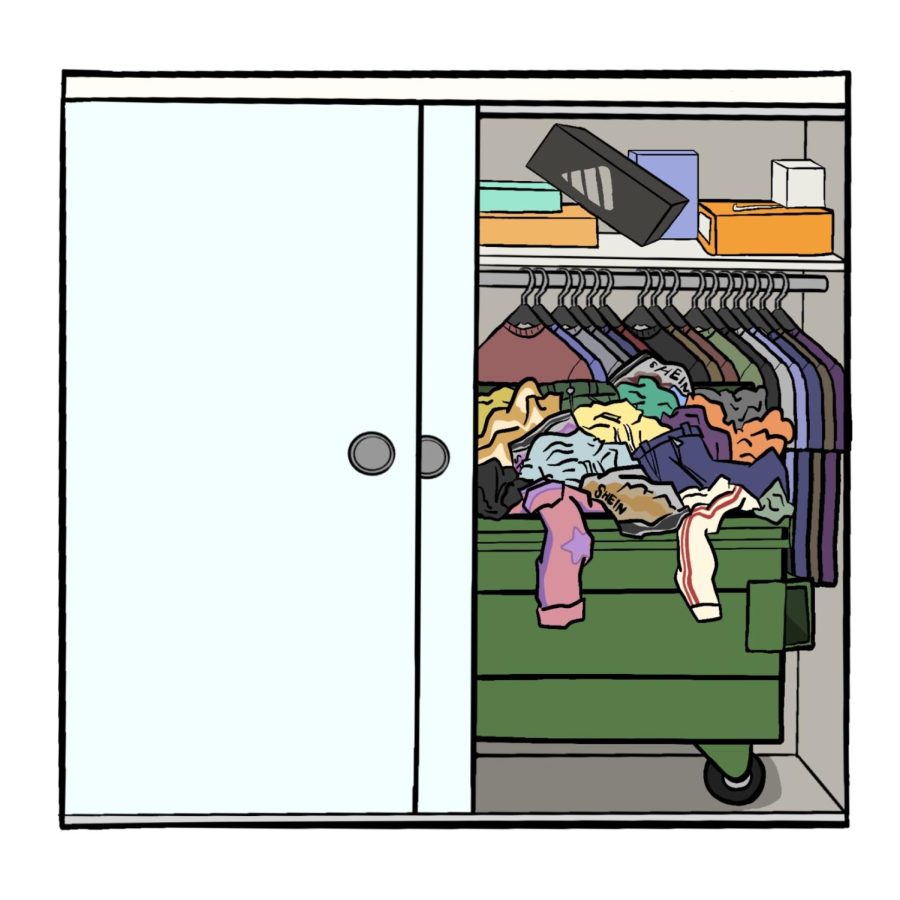Slow down fast fashion
Fast fashion isn’t as practical as it seems
Fast fashion is defined by Merriam Webster as “an approach to the design, creation, and marketing of clothing fashions that emphasizes making fashion trends quickly and cheaply available to consumers.” Fast fashion has always been around, but it has made a comeback since 2020. Everything was expensive at the time due to inflation and people spent a lot of time online shopping due to quarantine. Fast fashion makes it easy for teenagers to keep up with trends while spending as little as possible.
“It may sound like a broken record [that fashion] is a form of self expression, just being able to feel comfortable and feel positive in the clothes that you wear. It allows us to be creative in any way, shape, or form. Depending on our style, depending on what we like,” junior and avid fast fashion consumer Alexander Roman said.
Although these clothes are cheaper and fit in with the trends, students don’t acknowledge the consequences of buying fast fashion. Some may not even know what fast fashion is. International Baccalaureate Environmental System and Societies and Accelerated Biology teacher Jennifer Ekstein explains what fast fashion is and its downsides
“Clothes from these online stores are from very cheap overseas companies. [People buy] seasonal clothes that are in style for the moment and then eventually throw them away,” Ekstein said. “The fibers are made of material like polyester and polyester-derivatives from fossil fuels. So you’re contributing to climate change in the manufacturing process.”
These clothes are often mass-produced which leads them to being sold at a cheaper price. This leads to stores at the mall having the same clothing styles. Along with that, the clothes are only seasonal, meaning they are only meant to last a certain period of time. While some people say fast fashion is inexpensive, senior Isabella Gutierrez who is an advocate for thrifting finds it expensive.
“When I went to the stores, such as malls, I couldn’t really find stuff that I liked. I also couldn’t find things that were inexpensive. A lot of things are very expensive,” Gutierrez said.
Marketing is also a very important detail to acknowledge when it comes to buying from fast fashion companies. Influencers with a large audience are often paid to promote their products from the company. With the amount of people they can reach, buyers are more inclined to buy the products when their favorite celebrity or influencer shows them off.
“There’s unfortunately a lot of influencers on social media that contribute to fast fashion, because the media is so fast, broad and global. You can advertise a piece, like on Instagram or Facebook and instantly, it can sell out immediately,” Ekstein said.
Even though fast fashion is everywhere, there are ways to give back to the environment and reduce the consumption of fast fashion. Going thrifting, for example, is an environmentally friendly way of shopping that is in style right now.
“There’s a lot of things you can buy from different decades. It’s like a bunch of different styles you can explore. I think that when you buy stuff at malls or outlets, it can be very limiting since they follow trends,” Gutierrez said.
“I donate [my clothes] to a program down in Tijuana with my family to give to little kids who aren’t as fortunate to have clothes. Or I pass my clothes down to younger family members,
— Alexander Roman
“I donate [my clothes] to a program down in Tijuana with my family to give to little kids who aren’t as fortunate to have clothes. Or I pass my clothes down to younger family members,” Roman said.
Buying more sustainable and durable clothing will last a longer time. Recycling and upcycling clothes are other alternatives to consuming fast fashion. Upcycling, or taking a product that you would otherwise throw away and giving it a second life, can help reduce landfill waste.
“I donate [my clothes] to a program down in Tijuana with my family to give to little kids who aren’t as fortunate to have clothes. Or I pass my clothes down to younger family members,” Roman said.
Ekstein suggests that fast fashion consumers should educate themselves on how harmful fast fashion can be. Consumers can be fashionable and sustainable if they have knowledge on the products they buy and the companies those products are from.
“I don’t think people understand what the consequences are of wearing fast fashion,” Ekstein said. “The real big [way to avoid fast fashion] is education, but they’re not going to get that unless they really either understand it, or hear it specifically.”

I am a senior at Bonita Vista High and this is my first year on staff. This year, I am one of the photographers for the Crusader. I joined newspaper seeking...

I am a senior at Bonita Vista High (BVH) and a Sports Editor for the Crusader. I joined staff in the second semester of last year on a whim and became...

















Gail Levine • Mar 24, 2023 at 7:44 am
Do you know about The Princess Project? We give free prom dresses to high school students. Go to our website for all the information. Any high school student that is going to prom can sign up to come get a free dress!
Google Princess Project San Diego to find our website because I cannot leave a link in the comments.
Check it out.
Sustainable fashion. Affordability. Win-win